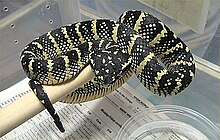Tropidolaemus wagleri
| Tropidolaemus wagleri | |
|---|---|
 |
|
| Scientific classification | |
| Kingdom: | Animalia |
| Phylum: | Chordata |
| Subphylum: | Vertebrata |
| Class: | Reptilia |
| Order: | Squamata |
| Suborder: | Serpentes |
| Family: | Viperidae |
| Subfamily: | Crotalinae |
| Genus: | Tropidolaemus |
| Species: | T. wagleri |
| Binomial name | |
|
Tropidolaemus wagleri (F. Boie, 1827) |
|
| Synonyms | |
|
|
Tropidolaemus wagleri is a venomous pitviper species native to South-East Asia. No subspecies are currently recognized. It is sometimes referred to as the temple viper because of its abundance around the Temple of the Azure Cloud in Malaysia.
The specific name, wagleri, is in honor of German herpetologist Johann Georg Wagler.
This species is sexually dimorphic: the females grow to approximately 1 m (39 1⁄4 in) in total length, while males typically do not exceed 75 cm (29 1⁄2 in). They have a large triangular-shaped head, with a relatively thin body. They are almost entirely arboreal, and the tail is prehensile to aid in climbing.
They are found in a wide variety of colors and patterns, often referred to as "phases". In the past, some researchers classified the different phases as subspecies. The phases vary greatly from having a black or brown coloration as a base, with orange and yellow banding to others having a light green as the base color, with yellow or orange banding, and many variations therein.
Wagler's pit viper, temple viper, temple pit viper, bamboo snake, temple snake, speckled pit viper, temple pitviper.
Found in southern Vietnam from the provinces of Minh Hai and Song Be, in southern Thailand recorded from the provinces of Phang Nga, Pattani, Surat Thani, Nakhon Si Tammarat, Narathiwat, and Yala, probably distributed throughout the Peninsula in west Malaysia, as well as the island of Penang, in Singapore and in Indonesia on Sumatra, the islands of the Riau Archipelago, Bangka, Billiton, Nias, the Mentawai Islands (Siberut), Natuna, and Karimata. "In a revision by Vogel et al. (2007) the Tropidolaemus wagleri species complex was differentiated into several taxa, including the resurrection of T. subannulatus. The Western Philippine populations belong to T. subannulatus, but those from Mindanao include snakes assigned to both this species and T. philippensis. Tropidolaemus subannulatus has a wide distribution in Central Indonesia, Malaysia and Philippines, T[ropidolaemus] wagleri is restricted to mainland Southeast Asia, down to Sumatra and Bangka, West Indonesia."
...
Wikipedia

